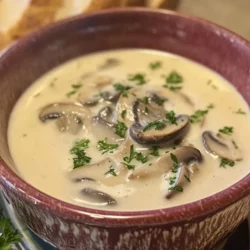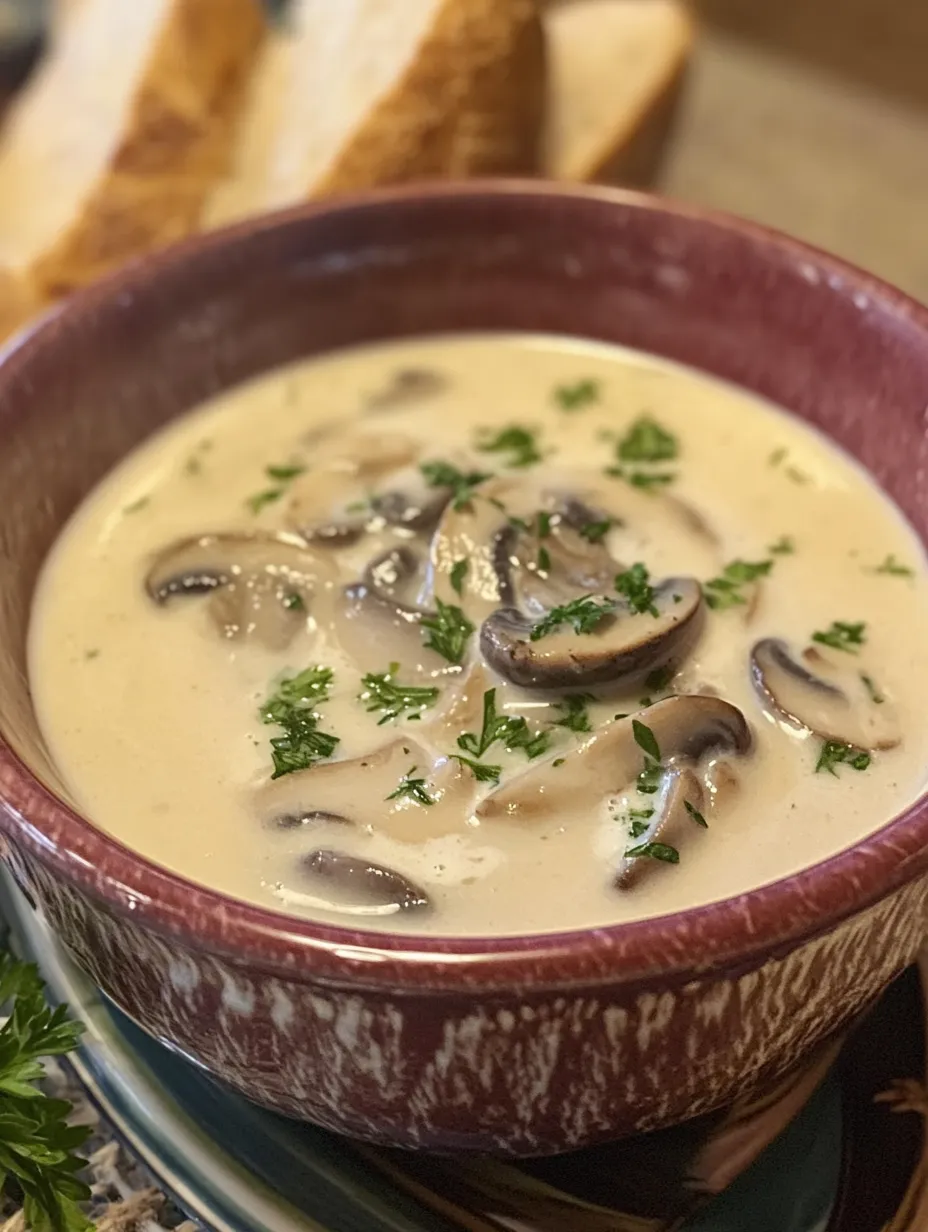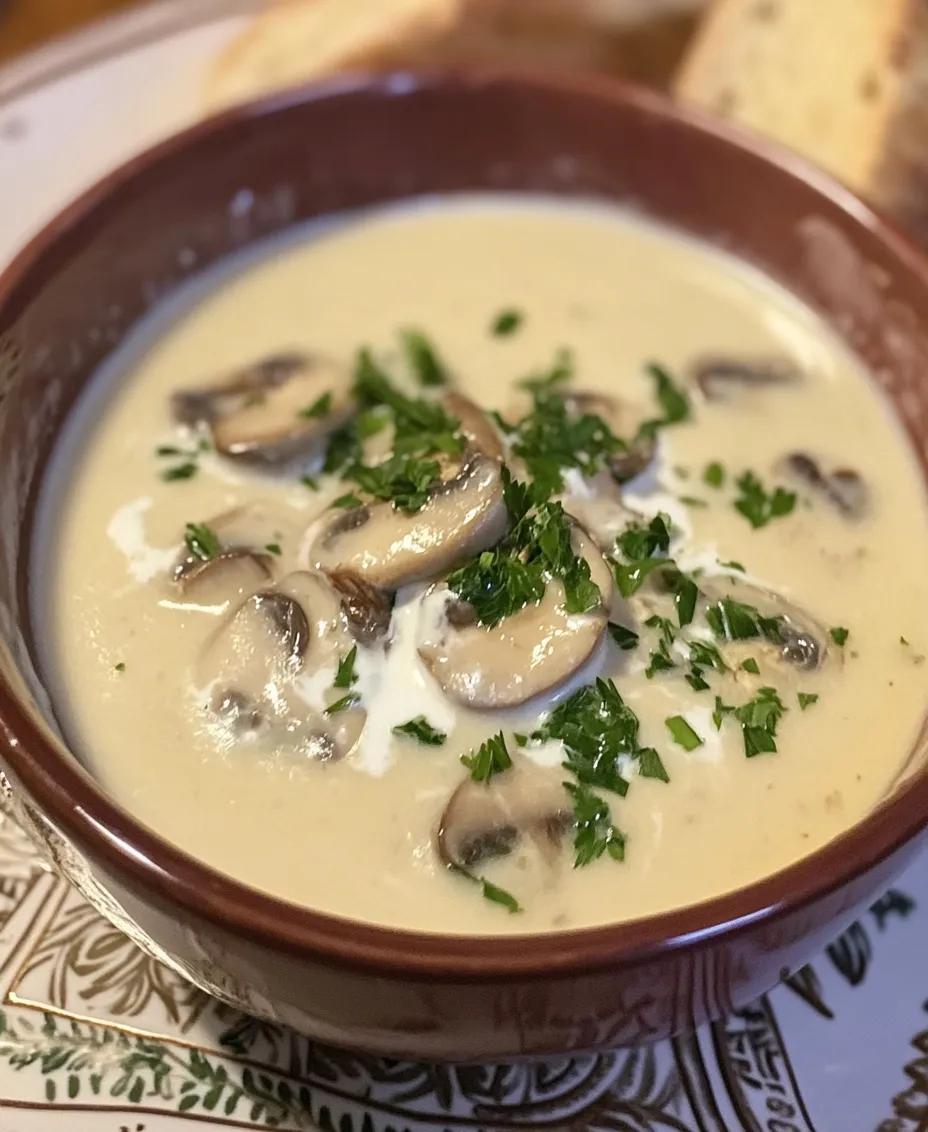Introduction
Mushroom soup is a beloved classic in various cuisines around the world, celebrated for its comforting warmth and rich flavor profile. From elegant French bistros to cozy family kitchens, mushroom soup has established itself as a staple comfort food, with each region adding its own unique twist. The creamy texture and earthy flavors make it an irresistible choice for many, often evoking feelings of nostalgia and home-cooked warmth. As the seasons change and the weather turns cooler, a steaming bowl of mushroom soup becomes an ideal dish, providing both nourishment and comfort.
In the world of comfort food, the importance of rich and creamy textures cannot be overstated. Cream-based soups, particularly mushroom soup, offer a sense of indulgence that soothes the soul. The luxurious mouthfeel combined with the umami-rich flavor of mushrooms creates a delightful experience that is hard to resist. Today, we are diving into a delightful recipe that elevates the traditional mushroom soup to new heights: the Dreamy Cream of Mushroom Soup Enhancement. This recipe is designed for home cooks and food enthusiasts alike, promising to deliver an unforgettable culinary experience that will impress family and friends.
The Allure of Mushroom Soup
Mushroom soup boasts a rich history that spans centuries and cultures. It has roots in European cuisine, particularly in France, where it has been a beloved dish since at least the 18th century. The classic French version often features a blend of wild mushrooms, cream, and stock, capturing the essence of the forest in a bowl. Over time, variations have emerged globally, with each culture adding its unique ingredients and cooking techniques. From Italian porcini mushroom soup to the heartier Russian mushroom solyanka, the versatility of mushroom soup knows no bounds.
Beyond its historical significance, mushroom soup also offers numerous nutritional benefits. Mushrooms are low in calories yet rich in essential nutrients, including vitamins B and D, selenium, and antioxidants. When combined with cream, they create a satisfying dish that provides both flavor and nourishment. Creamy soups can also be a source of healthy fats, especially when prepared with high-quality ingredients. Homemade mushroom soup, in particular, allows you to control the ingredients, ensuring a dish that is not only delicious but also free from preservatives and excess sodium often found in canned options.
The difference between homemade and canned mushroom soup is stark. While canned varieties may offer convenience, they often fall short in terms of flavor and nutritional value. Homemade soup allows you to choose the freshest ingredients, resulting in a vibrant and flavorful dish that far surpasses its store-bought counterparts. The ability to customize flavors and textures according to personal preference makes homemade mushroom soup an appealing option for anyone looking to elevate their cooking.
Ingredient Breakdown
Fresh Mushrooms
The heart of any mushroom soup is, of course, the mushrooms themselves. When crafting your Dreamy Cream of Mushroom Soup, the choice of mushrooms can significantly impact the flavor profile. Cremini and button mushrooms are two popular options. Button mushrooms, known for their mild taste and firm texture, are widely available and serve as a great base. However, for a more robust flavor, cremini mushrooms are an excellent choice. Their deeper, earthier tones add complexity, making the soup more satisfying.
For an even more decadent experience, consider incorporating a mix of mushrooms. Adding shiitake or porcini mushrooms can introduce an intense umami flavor that elevates the dish. For a truly gourmet version, you might even experiment with wild mushrooms, which can provide unique textures and flavors that are hard to replicate with standard varieties.
Aromatics
Aromatics play a crucial role in developing the flavor of mushroom soup. Onions and garlic are classic choices that provide depth and richness to the dish. When sautéed, they release their natural sweetness, enhancing the overall flavor profile of the soup. Yellow onions are typically used for their balanced sweetness, but feel free to experiment with shallots or red onions for a different taste.
Garlic, on the other hand, adds a fragrant aroma and a subtle kick. The key to achieving the perfect balance is to sauté the onions until they become translucent before adding the garlic. This technique allows the garlic to infuse its flavor without burning, which can lead to a bitter taste. By carefully managing the cooking of these aromatics, you set a solid foundation for the rich flavors that will follow.
Creamy Elements
The creamy texture of the soup is what truly makes it dreamy. Heavy cream is the traditional choice, lending a luscious richness that envelops each spoonful. For those looking for alternatives, there are several substitutes available. Half-and-half can be used for a lighter version, while coconut cream offers a dairy-free option with a hint of tropical flavor. However, keep in mind that these substitutes may alter the overall taste and texture of the soup.
If you’re aiming for a healthier version, consider using a blend of milk and Greek yogurt. This combo can still achieve creaminess while lowering the overall fat content. Regardless of the choice, the creamy element is essential for achieving that velvety mouthfeel that makes mushroom soup so irresistible.
Broth Choices
The type of broth you use can significantly influence the flavor of your mushroom soup. Vegetable broth is often preferred for a vegetarian option, providing a mild base that allows the mushroom flavors to shine. However, chicken broth can impart a richer, more savory taste, enhancing the overall complexity of the soup. The choice between these two options ultimately comes down to personal preference and dietary restrictions.
For a more intense flavor, consider making your own broth. Homemade broth can be customized with herbs and spices, resulting in a depth of flavor that is hard to achieve with store-bought varieties. If you opt for a packaged broth, look for low-sodium versions to better manage the saltiness of the final dish.
Umami Enhancers
To elevate the soup’s flavor profile, incorporating umami enhancers can make a significant difference. Soy sauce and Worcestershire sauce are two excellent choices that add depth and complexity. A splash of soy sauce can introduce a savory richness, while Worcestershire sauce adds a hint of tanginess.
White wine is another fantastic addition that can elevate the soup’s flavor. Not only does it help deglaze the pan, but it also adds acidity and brightness, balancing the richness of the cream. When choosing wine, opt for a dry variety that complements the earthy flavors of the mushrooms without overpowering them.
Herbs and Seasonings
Fresh herbs and seasonings are essential for adding brightness and aroma to your mushroom soup. Thyme is a classic herb that pairs beautifully with mushrooms, providing an earthy, floral note that enhances the overall flavor. Whether you choose to use fresh or dried thyme, this herb is a must-have for your soup.
Fresh parsley adds a pop of color and a fresh, vibrant taste to the dish. It can be sprinkled on top of the soup just before serving, providing a delightful contrast to the creamy texture. Other herbs, such as rosemary or chives, can also be used to customize the flavor profile according to your preferences.
Preparation Steps Detailed
Sautéing Aromatics
The first step in creating your Dreamy Cream of Mushroom Soup is to sauté the aromatics. Begin by heating a generous amount of olive oil or butter in a large pot over medium heat. Once the oil is hot, add the diced onions. Sauté them for about 5-7 minutes, or until they become translucent and fragrant. This initial cooking process releases the natural sugars in the onions, developing a sweet and savory base for the soup.
After the onions are softened, add minced garlic. Stir continuously for about 30 seconds to 1 minute, allowing the garlic to release its aroma. Be careful not to let it brown, as burnt garlic can impart a bitter flavor to the soup. Once the garlic is fragrant, you are ready to move on to the next step.
Cooking Mushrooms
With the aromatics sautéed to perfection, it’s time to add the fresh mushrooms. Depending on the quantity, you may need to work in batches to avoid overcrowding the pan. Overcrowding can lead to steaming rather than browning, which will diminish the flavor. Add the sliced mushrooms and cook them for about 8-10 minutes, stirring occasionally. As the mushrooms cook down, they will release their moisture, intensifying their flavor.
To achieve the perfect browning on the mushrooms, allow them to sit undisturbed for a few minutes before stirring. This technique encourages caramelization, which enhances the overall depth of flavor in the soup. Once the mushrooms are beautifully browned and tender, you’re ready to take the next step.
Deglazing Techniques
After the mushrooms have reached their peak flavor, it’s time to deglaze the pot. Pour in a splash of white wine and use a wooden spoon to scrape up any brown bits stuck to the bottom of the pot. This step is crucial, as those browned bits are packed with flavor that will enrich your soup. Allow the wine to simmer for a couple of minutes, cooking off the alcohol and leaving behind a subtle acidity that balances the richness of the cream.
By following these preparation steps, you lay the groundwork for a Dreamy Cream of Mushroom Soup that is not only delicious but also showcases the natural flavors of the ingredients. Each stage is designed to enhance the overall experience, ensuring that every bowl is an indulgent treat perfect for any occasion.
Stay tuned for the next part of this article, where we will dive deeper into the final steps of the recipe, including the addition of creamy elements, seasoning adjustments, and tips for serving this delightful soup.
Adding Liquid Ingredients
In crafting a Dreamy Cream of Mushroom Soup, the addition of liquid ingredients is a pivotal step that enhances both texture and flavor. Start by gradually incorporating vegetable or chicken broth into the sautéed mushrooms and aromatics. The simmering process is essential, allowing the flavors to meld beautifully. As the broth heats, it extracts the umami notes from the mushrooms while integrating with the aromatic base of onions and garlic. This melding of flavors occurs best when the soup is allowed to simmer gently, so keep the heat at a low to medium setting. Aim for a simmer, not a rolling boil, which can cause the flavors to dissipate rather than deepen.
After adding the broth, allow the soup to simmer for at least 20-30 minutes. This not only helps to develop a richer flavor profile but also softens the mushrooms and onions, creating a wonderful, cohesive blend. For those who prefer a heartier soup, consider adding a splash of white wine or sherry during this stage for an additional layer of complexity. The acidity from the wine can brighten the overall flavor, making the soup even more delightful.
Blending the Soup
Once the soup has simmered and the flavors have fully developed, it’s time to blend. You can choose between two popular methods: immersion blending or using a stand blender. An immersion blender is a handy tool that allows you to blend the soup directly in the pot, minimizing mess and making it easy to achieve your desired consistency. Simply submerge the blender, turn it on, and move it around until the soup reaches a creamy texture.
On the other hand, if you prefer a stand blender, carefully transfer the soup in batches to avoid spills and burns. Stand blenders often provide a smoother finish, particularly if you’re aiming for a silkier texture. Remember to leave a small gap in the blender lid to allow steam to escape, preventing any pressure build-up that might cause a splatter.
Finishing Touches
The final touches of the Dreamy Cream of Mushroom Soup are crucial to elevating its flavor profile. After blending, return the soup to the pot and stir in heavy cream and a squeeze of fresh lemon juice. The cream adds a rich, velvety texture, while the lemon juice brightens the overall flavor and balances the richness. It’s important to add these ingredients after blending to maintain their freshness and prevent the cream from curdling. Aim to incorporate the cream gently over low heat, ensuring it is warmed through without boiling.
Additionally, consider seasoning with freshly cracked black pepper and salt to taste. A touch of nutmeg can also provide an intriguing warmth and depth to the soup, complementing the earthiness of the mushrooms beautifully.
Serving Suggestions and Pairings
When it comes to serving your Dreamy Cream of Mushroom Soup, there are a variety of accompaniments that can enhance the experience. A slice of crusty bread, such as a sourdough or baguette, is a classic pairing that complements the creamy texture of the soup. You can toast the bread lightly, adding a drizzle of olive oil or a sprinkle of garlic powder for an extra flavor kick.
For a lighter option, consider serving the soup alongside a fresh salad. A mixed greens salad with a zesty vinaigrette or a Caesar salad can add a nice contrast to the richness of the soup.
Creative Garnishing Ideas
Garnishing your soup not only adds visual appeal but can also enhance the flavor profile. Consider topping each bowl with a dollop of crème fraîche or a swirl of additional cream for presentation. Fresh herbs such as parsley, chives, or thyme can provide a pop of color and freshness. If you want a bit of crunch, sprinkle some toasted pine nuts or croutons on top for texture. A light dusting of smoked paprika can also enhance the flavor while adding an attractive color contrast.
Presentation Tips
To create an appealing visual experience, serve the soup in elegant bowls, preferably ones with a wide rim that allows for creative garnishing. Pour the soup carefully to avoid spills, and take a moment to adjust any toppings before serving. Adding a sprig of fresh herb on top not only adds color but also acts as a visual cue for the flavors within. If you’re feeling adventurous, consider using a soup tureen for a more formal presentation, allowing guests to serve themselves.
Nutritional Analysis
Understanding the nutritional profile of your Dreamy Cream of Mushroom Soup is essential for those mindful of their dietary choices. On average, a serving of this creamy soup contains approximately 250-300 calories, depending on the amount of cream used and any additional ingredients added.
Dietary Considerations
For those seeking alternatives, there are several options available. For a lactose-free version, substitute heavy cream with coconut cream or a plant-based milk such as almond or oat milk. These alternatives will still provide a creamy texture while accommodating those with lactose intolerance. Additionally, using low-sodium broth can make this soup more heart-healthy, as it reduces the overall sodium content.
Mushrooms are packed with nutrients, offering a good source of vitamins D and B, as well as antioxidants. They can support immune function and contribute to overall health. Incorporating cream, while rich, also provides essential fats that can be part of a balanced diet when consumed in moderation.
Variations and Customizations
One of the joys of making a Dreamy Cream of Mushroom Soup is the ability to customize it according to your preferences. Experimenting with different types of mushrooms can yield exciting variations in flavor. Shiitake mushrooms bring a rich, earthy taste, while portobello mushrooms add a meaty texture that can enhance heartiness. Wild mushrooms, such as chanterelles or morels, can introduce unique flavors, making your soup a gourmet experience.
Cream Alternatives
For those seeking dairy-free options, consider using coconut cream or nut-based milks. Coconut cream contributes a subtle sweetness and a creamy texture, while nut-based milks, like cashew or macadamia, provide a rich mouthfeel without the dairy. Be sure to adjust seasoning as needed, as these alternatives can slightly alter the flavor profile.
Adding Proteins
To make the soup a complete meal, consider adding proteins. Shredded chicken or diced tofu can be stirred into the soup before serving, providing additional substance and making it more filling. For a vegetarian option, try incorporating legumes like chickpeas or white beans, which can add both protein and fiber, making the soup heartier and more satisfying.
Conclusion
The Dreamy Cream of Mushroom Soup Enhancement is a versatile dish that embodies warmth and comfort, making it a perfect choice for any occasion. Its rich, creamy texture combined with the earthy flavors of mushrooms creates a bowl of pure delight that can be customized to fit various dietary needs and taste preferences.
As you explore and personalize this recipe, remember that the true charm of homemade soups lies in their ability to adapt to your tastes. Whether you stick to the classic recipe or venture into exciting variations with different mushrooms, cream alternatives, or protein additions, each bowl serves as a canvas for your culinary creativity.
Creating homemade soups not only nourishes the body but also feeds the soul with comfort and warmth. Enjoy the process of crafting this delightful dish, and don’t hesitate to share your unique twists on this classic recipe with family and friends. Let each spoonful inspire joy and satisfaction, making every meal an experience to remember.



